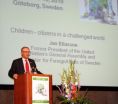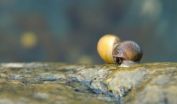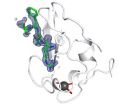(Press-News.org) Scientists at Emory University School of Medicine have uncovered how a structural component inside neurons performs two coordinated dance moves when the connections between neurons are strengthened.
The results are published online in the journal Nature Neuroscience, and will appear in a future print issue.
In experiments with neurons in culture, the researchers can distinguish two separate steps during long-term potentiation, an enhancement of communication between neurons thought to lie behind learning and memory. Both steps involve the remodeling of the internal "skeletons" of dendritic spines, small protrusions on the surface of a neuron that receive electrical signals from neighboring cells.
The results hint at why people with Williams syndrome, a developmental disorder caused by a deletion of several genes, including one that alters dendritic spine remodeling, have such an unusual blend of cognitive strengths and weaknesses.
The senior author of the paper is James Zheng, PhD, professor of cell biology and neurology at Emory University School of Medicine. The paper's co-first authors are graduate student Jiaping Gu, now a postdoctoral researcher at New York University, postdoc Chi Wai Lee and graduate student Yanjie Fan.
"We've been looking at the remodeling of dendritic spines, which is a fundamental process for reshaping circuits in the brain," Zheng says. "The anatomy of dendritic spines is altered in many diseases, such as fragile X syndrome and schizophrenia, as well as neurodegenerative disorders like Alzheimer's."
During the process of long-term potentiation, dendritic spines both enlarge and display a greater density of neurotransmitter receptors, the receiver dishes that allow neurons to detect the waves of chemicals other neurons are sending them.
Zheng's team studied this process by engineering a type of neurotransmitter receptor to be fluorescent when introduced into neurons. This particular engineered receptor is fluorescent only when it's on the surface of a cell.
"This allows us to directly visualize the addition of these receptors to the spine surface from their internal stores," he says.
The researchers tested how the movement of the receptors was tied to remodeling of the internal skeleton of the cell, by using drugs that either loosen or freeze the actin cytoskeleton, which forms the main structural support inside dendritic spines.
They then investigated the family of proteins called ADF (actin depolymerizing factor)/cofilin, which Zheng describes as acting like a pair of scissors, severing the links of the actin cytoskeleton.
"Our results suggest that there are two activities that need to be coordinated to strengthen dendritic spines: the cell has to cut actin filaments in order to allow receptors in storage to be added to the surface, but then it has to put away the scissors and stabilize and enlarge the spines," Zheng says.
Williams syndrome is a rare developmental disorder caused by a chromosomal deletion spanning 28 genes, several of which may contribute to changes in cognitive development. One of the genes thought to be responsible encodes the enzyme LIM kinase 1. LIM kinase deactivates ADF/cofilin, which means neurons in Williams syndrome may have an altered ability to remodel dendritic spines.
Williams syndrome impairs affected individuals' perceptions of space as well as their ability to make social judgments, but tends to leave other functions relatively intact. Individuals with Williams syndrome are noted to have an affinity for language and music.
"Cytoskeletal remodeling is required for some aspects of long-term potentiation but also needs to be reigned in. If we change LIM kinase or ADF/cofilin and shift the balance of the cytoskeletal remodeling, that could affect some cognitive processes and not others," Zheng proposes. He also believes that the actin cytoskeleton and its regulation by ADF/cofilin, can be a likely target affected by many neurological disorders involving impaired brain functions.
Pharmaceutical companies have been testing inhibitors of LIM kinases as potential drugs for treating glaucoma, cancer and other diseases. Zheng's team's results indicate that manipulating LIM kinase with drugs could end up perturbing or impairing cognitive processes, he says.
"However, it also could mean that there is a window of time where you could possibly enhance learning or memory formation, based on the dynamics of dendritic spine remodeling," he says.
INFORMATION:
The research was supported by the National Institutes of Health.
Gu et al. ADF/cofilin-mediated actin dynamics regulate AMPA receptor trafficking during synaptic plasticity. Nature Neurosci. Advance online pub. (2010)
Writer: Quinn Eastman
END
A new University of Colorado at Boulder study sheds light on the brain mechanisms that allow us to make choices and ultimately could be helpful in improving treatments for the millions of people who suffer from the effects of anxiety disorders.
In the study, CU-Boulder psychology Professor Yuko Munakata and her research colleagues found that "neural inhibition," a process that occurs when one nerve cell suppresses activity in another, is a critical aspect in our ability to make choices.
"The breakthrough here is that this helps us clarify the question of what is happening ...
WASHINGTON, September 13 – Developing renewable energy sources has never been more important, and solar photovoltaic (PV) technologies show great potential in this field. They convert direct sunlight into electricity with little impact on the environment. This field is constantly advancing, developing technologies that can convert power more efficiently and at a lower cost. To highlight breakthroughs in this area, the editors of Energy Express, a bi-monthly supplement to Optics Express, the open-access journal of the Optical Society (OSA), today published a special Focus ...
AMARILLO - Apply today's chemicals to a sorghum crop for grass control and the sorghum will be killed off also. But a solution could be only a few years away if Texas AgriLife Research plots are any indication.
Dr. Brent Bean, AgriLife Research and Texas AgriLife Extension Service agronomist, has test plots that demonstrate sorghum hybrids tolerant to herbicides typically associated with grass control.
The control is needed not only for annual grass control but also for Johnsongrass, Bean said. Because Johnsongrass is closely related to grain sorghum, herbicides typically ...
Athens, Ga. - A new University of Georgia study has found that select varieties of sorghum bran have greater antioxidant and anti-inflammatory properties than well-known foods such as blueberries and pomegranates.
Researchers measured polyphenolic compounds, which naturally occur in plants to help fight against pests and disease, and found that the black and sumac varieties of sorghum have significant levels of antioxidants. Many fruits also contain these compounds, they said, though sorghum bran may prove to be the richest and cheapest source.
"Since most human chronic ...
David H. Adams, MD, Marie-Josée and Henry R. Kravis Professor and Chairman of the Department of Cardiothoracic Surgery at The Mount Sinai Medical Center, has performed the first implantation of the Medtronic Tri-Ad Semi-Flexible Tricuspid Annuloplasty Ring in the United States. Dr. Adams invented the ring, which was recently approved by the Food and Drug Administration.
The tricuspid valve lies between the right atrium and right ventricle of the heart. Tricuspid valve regurgitation occurs when the valve does not close completely and blood leaks back into the right atrium ...
A group of children who underwent fusion surgery for spondylolisthesis in the lumbar spine 30 years ago showed a clear reduction in back pain when followed up seven years later. A new study of these patients as adults has found that the benefits have lasted, reveals research from the Sahlgrenska Academy and Sahlgrenska University Hospital presented this week at the International Society of Orthopaedic Surgery and Traumatology (SICOT) annual international conference in Gothenburg.
Spondylolisthesis (forward displacement of a vertebra) in the lumbar spine occurs in 6% ...
Today sees the presentation of a study that, for the first time, shows the results of treatment using prostheses attached to titanium implants in the bones of patients with above-the-knee amputations. It reveals that the treatment improves function and quality of life in nine out of ten patients, and is the result of research carried out at the Sahlgrenska Academy and Sahlgrenska University Hospital that is being presented this week at the International Society of Orthopaedic Surgery and Traumatology (SICOT) annual international conference in Gothenburg.
At a symposium ...
Early childhood education can play a key role in relation to change when the world fails to adopt a sustainable approach economically, ecologically and socially.
This was highlighted at the World Congress "Children, citizens in a challenged world", which was hosted by the University of Gothenburg.
In a statement, the congress urges governments around the world to protect children's right to a childhood.
More and more people are realising that work with young children is a force for change in itself, towards creating a different society. Early childhood education has ...
Sexual conflict is not only a human phenomenon. Scientists at the University of Gothenburg have shown that females of the rough periwinkle conceal their gender identity in order to avoid excessive copulation.
The females of most species of snail excrete a substance in their mucous trails that enables males to find them more easily, since they can distinguish between trails from females and those from other males. The males follow the mucous trails laid down by females in order to find a partner for mating. However, the females of one of the species studied (Littorina ...
VIDEO:
This video shows UBR-box recognition of an arginine residue at the beginning of a protein (blue) targeted for degradation. The structural integrity of the UBR box depends on zinc (grey)...
Click here for more information.
Our bodies recycle proteins, the fundamental building blocks that enable cell growth and development. Proteins are made up of a chain of amino acids, and scientists have known since the 1980s that first one in the chain determines the lifetime ...


